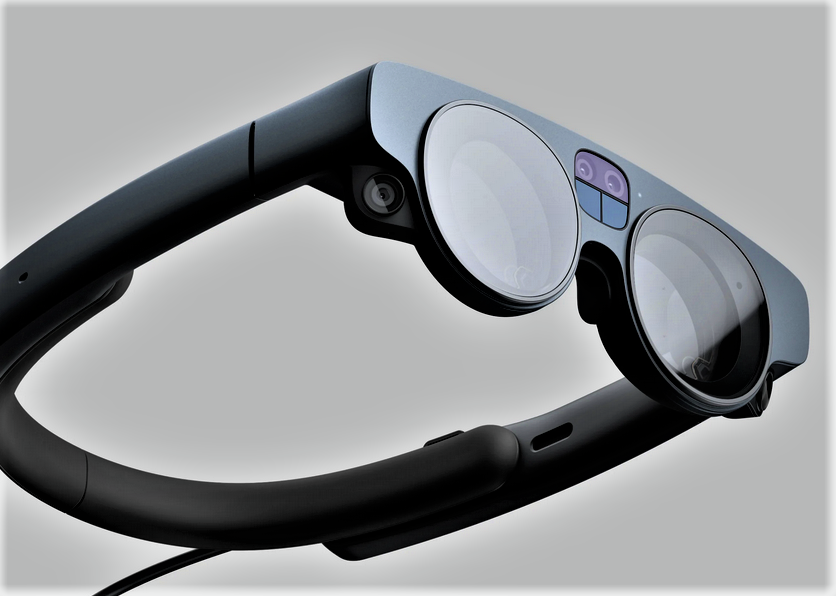
Magic Leap has returned with a new Augmented Reality (AR) enterprise headset priced at $4,999.
Along with new leadership and a new enterprise focus, rather than its initial failed bid to win over consumers, the company has also swapped out the engine of its new, lighter and more powerful AR headset significantly.
Magic Leap 2 is now based on an x86 architecture (AMD 7nm Zen 2 CPU) rather than Arm.
It is also now running on Android 10 (API level 29) rather than the homegrown “Lumin” Operating System (OS) used in its Magic Leap 1 back in 2018. The release firmly takes the fight to Microsoft's Hololens 2.
Magic Leap's CEO Peggy Johnson describes it as "the industry’s smallest and lightest device built for the enterprise". It ships with a 5H x 55V (70° diagonal) field of view, a resolution of 1440 x 1760 and new controller technology. Impressively, it weighs less than half of Microsoft's 566g Hololens 2, at just 260g.

It also ships with WiFi 6, a 12.6MP camera, and 90fps eye tracking.
What happened to Magic Leap?
Dubbed the “world’s hottest startup” by Wired in 2016; derided in 2018 for the vast gulf between its promotional videos and the reality of its performance; valued at $6.7 billion at its highs; nearly underwater in 2019, when it handed 1,903 patents to investors as collateral...
Stakeholders lost patience with the widely hyped, perennially-on-the-verge-of-something-magical startup in 2020, when Magic Leap fired a reported 1,000 staff; won a $500 million lifeline at a $2 billion valuation (yes, a similar raise at a similar valuation to the one it had achieved back in 2014), wound down its consumer business, and replaced its founder Rony Abovitz with former Microsoft and Qualcomm VP Peggy Johnson as new CEO.
Magic Leap’s had quite a ride – reported along the way with cutting lines like these: “The line between overpromising, an inability to deliver and fraud on something that has never been done is blurry” – but is clearly now trying to fight back with less hype and a more solid product; the early specs certainly look impressive.
Can Magic Leap 2 help a troubled brand recover?
Johnson, announcing Magic Leap 2's general availability on Sep 30, said: "[Our work on the new headset has] resulted in more than 3,000 product and platform innovations... We understand better than anyone the remaining hurdles that hold back widespread AR adoption, and we’ve worked tirelessly to solve those challenges.
"Magic Leap 2 was purpose-built to begin breaking down the barriers that have held back the adoption of AR technology – hot, heavy, clunky headsets, low-quality visuals, an inability to work well in bright/daylight environments, and overall discomfort... Magic Leap 2 is the industry’s smallest and lightest device built for the enterprise. It is the only device with innovative breakthroughs like our exclusive Dynamic Dimming technology, along with double the field of view, and unparalleled image quality, color fidelity, and text legibility. All of these innovations are critical to making AR a viable technology that can be used daily for training, communication, remote assistance, and 3D visualization in clinical, industrial environments, defense, and retail environments."
Pricing may prove a hurdle for some: A base edition Magic Leap 2 for developers starts at $3,299. The "Developer Pro" version, which still restricts use for application creation only and cannot be used in commercial deployments is $4,099. The full-fat Magic Leap 2 Enterprise starts at $4,999 which is far from cheap. That includes quarterly software releases "fully manageable via enterprise UEM/MDM solutions". Magic Leap says early adopters include Cisco and German medical technology company Brainlab, among others. As well as rivals like Microsoft's Hololens 2, Magic Leap is in an enterprise market in which smaller specialists like RealWear have also carved out a niche for less high-powered but rugged and effective stripped back headsets for use in industrial environments.
Time will tell if it can deliver a remarkable turnaround.
